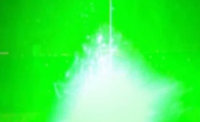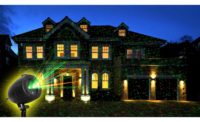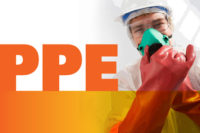Initial selection
Optical density. The protective goal of laser eyewear is such that if laser radiation strikes the lens portion of the eyewear, the lens will completely block or reduce any transmitted radiation to below the Maximum Permissible Exposure (MPE) level. This filtration or protection level is called optical density (OD).
For ultra-violet and infrared radiation, the OD selected should offer full protection, while for visible wavelengths, it is sometimes common to select less than full protection OD to allow some visibility of the beam for alignment purposes or beam manipulation. This becomes a challenge when beam output is less than 100 mW or the beam is expanded. The Laser Safety Officer (LSO) needs to be cognizant of the applications to avoid a situation where people remove or look over their eyewear to see the beam.
The only laser alignment standard for eyewear in the world is the EN208 standard originating in Germany and subsequently incorporated into the CE standard for Europe.
Only alignment eyewear is based on the following scale:
0-10mW O.D. 1-2
10-100mW O.D. 2-3
100mW -1W O.D. 3-4
1W- 10W O.D. 4-5
Wavelength coverage. When a laser user is using only 1 or 2 wavelengths, generally eyewear can be found. The more wavelengths one wishes the eyewear to protect against, the greater the challenge in finding one pair to do the job. The LSO needs to know all selected wavelengths/powers to be exposed, or each at selected applications. This can help determine if one pair will do or if 2 pairs or a flip-down style would be the best choice.
Labeling. ANSI Z136.1 requires laser protective eyewear to be labeled with the wavelength and OD it is intended for. The manufacturer will imprint on the eyewear the most common range of wavelengths and OD for a particular pair. For the vast number of laser users, this is satisfactory.
A small segment of users are using the eyewear for wavelengths not listed on them.
Curves and other documentation provided by the eyewear manufacturer will show the OD at the desired wavelength. To be ANSI compliant, the LSO needs to label eyewear or post the information where the eyewear is stored, and have a way to identify which pair is which.
“Eye-safe” lasers aren’t necessarily so. Do the calculations for OD and you will probably find these lasers require eyewear; they may be safe in the Retinal Hazard Region but not for the cornea.
Impact. The ANSI Z136.1 standard Safe Use of Lasers does not require laser protective eyewear to be ANSI Z87 compliant. ANSI Z87 is the standard for safety eyewear; the most common element is impact resistance.
The question of impact resistance needs to be addressed. Simply: is it needed or not?
If not, no further action is needed; if it is required, there are three options:
1. Obtain a pair of laser eyewear that is compliant with Z87 (many polymer eyewear are compliant).
2. Wear safety glasses over the laser eyewear.
3. Have glass laser eyewear hardened to meet Z87.
Choice 2 can affect comfort or the ease of wearing the protective eyewear and general vision, while Choice 3 will affect eyewear cost.
Irradiance. When looking at what type of eyewear to use, consider how long the filter will last when exposed to laser radiation. If you want to make sure eyewear will work for you, find out from the manufacturer the eyewear’s irradiance levels. If it has been tested with a laser, they should be able to give you the irradiance level the eyewear will withstand. This can help you decide on coated dielectric eyewear, glass or polymer eyewear.
Areas that affect compliance
Fit — Overall if a pair of protective eyewear does not fit properly, not only can it not perform its function to the required specifications but likelihood of it being used decreases.
One size does not fit all. One solution may be to place a strap across the back to keep the frame tight as necessary. Another solution may be flip-downs.
Manufacturers offer a range of options, including eyewear for slim and large faces. There are options for fitting different nasal profiles, including flat or low nasal profiles. Adjustable temple lengths, temples with grip ends, and Bayonet temples are all helpful fitting components. Eyewear with the new soft flexible fingers on the nosepiece that adjust and conform to any nasal profile and minimize slippage is very comfortable.
Weight — Weight of eyewear is a particular concern in the consideration of acquiring multi-wavelength or prescription eyewear. Depending on wavelength combination, 7 mm of glass is not unheard of. This thickness of glass two to three times a norm prescription eyewear may prove too uncomfortable for a user to wear for extended periods. This can lead to a lack of productivity or times of no eye protection. Some breakthrough in polycarbonate prescription flips and over-glasses may help improve this item, as well as new wrap-around frames that incorporate Rx holders.
Visual light transmission (VLT). The desire is to block out the wavelengths of concern but to allow sufficient visual light to pass through for good vision. The problem is with multi-wavelength applications; the percentage of VLT can range from 4 to 30 percent. VLT’s below 20 percent in a well lighted room can still yield a dark field of view. Be aware of the lighting conditions in which the eyewear will be used. If the room lighting is dim for experimental or process reasons, even a 30 percent VLT may present safety issues, pushing the needs for stronger engineering controls or local task lighting.
Other safety considerations
Ultrafast Lasers (femto, picoseconds exposures) should have eyewear meeting the EN “M” rating; some polymer lenses meet this requirement. Multi-wavelength operations and sensor card use should be deliberated. Peripheral vision and anti-fog lenses are considerations.
Cost is important, but also consider: what’s the cost of an eye?
References
1. Hecht, Jeff, Understanding Lasers, Second Edition. New York: IEEE Press, 1993: 401-402.
2. Laser Institute of America, ANSI Z136.1-2000. Orlando: LIA, 2000: 8-89.



